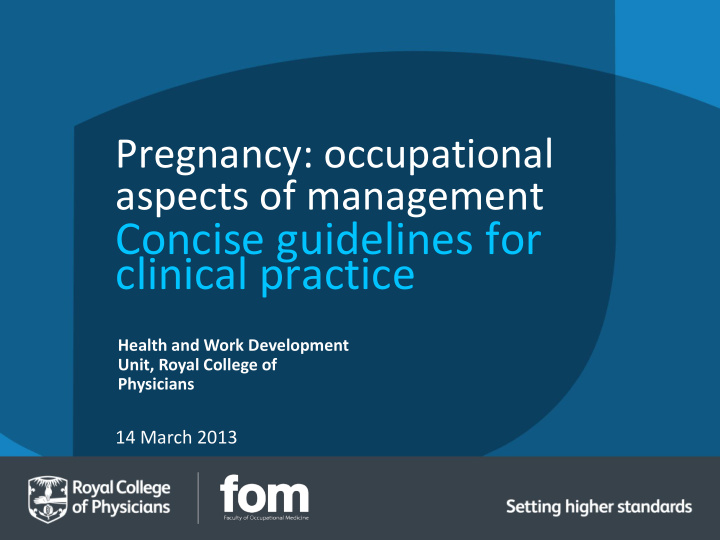



Pregnancy: occupational aspects of management Concise guidelines for clinical practice Health and Work Development Unit, Royal College of Physicians 14 March 2013
Members of GDG Prof Keith Palmer (chair) Prof Jens Peter Bonde Miss Elaine Scott, Consultant obstetrician Ms Jane Munro, Royal College of Midwives Ms Elizabeth Duff, National Childbirth Trust Ms Susan Murray, Unite, the Union Dr Sian Williams, Clinical director, HWDU Dr Nadia Sheikh, Consultant OH physician Dr Ira Madan, Consultant OH physician Dr Karen Walker-Bone, Consultant rheumatologist Dr Sara Hoffbrand, General practitioner
Background to the concise guideline • Builds on full guideline published in 2009 by the RCP • Systematic literature review was updated • Recommendations based on this evidence were developed by a multidisciplinary guideline development group • Funded by NHS Plus and the RCP
Aim of the guideline To enable evidence-based advice to be given in relation to pregnant women who are, or concerned they may be, exposed to certain hazards at work. The guidance is relevant to health professionals in primary and secondary care.
Patient group covered by the recommendations Healthy women with uncomplicated singleton pregnancies concerned about the risks from five common workplace exposures: • prolonged working hours (≥40h/week) • shift work (3-shift schedule or fixed nights) • lifting (typically 10-12kg) • prolonged standing (>4 h/day) • heavy physical workload
Adverse outcomes covered • miscarriage • preterm delivery • small for gestational age • low birth weight • pre-eclampsia and gestational hypertension (considered together).
Exclusions • adverse obstetric history • obstetric risk factors • pregnancy complications • pregnant with more than one baby These women should be advised to seek individualised advice from their obstetrician or midwife.
Methodology • Literature search: EMBASE, MEDLINE • Jan 1966 to June 13th 2012 (miscarriage). Jan 1966 to Dec 31st 2011 (other outcomes). • Exclusion processes/quality rating • Meta-analysis Sift & Literature Quality Meta- Scope Interpret exclude search rating analysis irrelevant
Overarching messages • All exposure-outcome pairs show v low or no risk to pregnancy • Larger, better quality studies more likely to show no risk ‘Current evidence offers no justification for imposing mandatory restrictions in relation to working hours, shift working, lifting and physical workload for pregnant women at work’
Overarching messages ‘Regardless of any potential risks to the fetus, the physiological demands of late pregnancy (after 28 weeks gestation) are such that women may struggle to cope with excessive work demands such as those covered by these guidelines. A good case exists for limiting them, and their employers should have regard to making reasonable adjustments to the worker’s job profile ’
Information sheets Available from: www.rcplondon.ac.uk/pregnancyguidelines
Information sheets • for health professionals • summarising the evidence for each exposure-outcome pair • available from the RCP website: www.rcplondon.ac.uk/pregnancyguidelines
Advising women on work patterns during pregnancy It should be recognised that there may be disadvantages to changing a pregnant worker’s shift pattern or refraining from work. Some women make a lifestyle choice to work fixed nights and find an imposed change to their shift pattern disruptive and stressful in itself.
Advising women on shift work and the risk of preterm delivery
Advising women on shift work and the risk of miscarriage 3 shift schedule Fixed nights
Advising women on activities undertaken at work during pregnancy Keeping active is generally thought to be healthy for pregnant women. This should be taken into account when considering whether, and by how much, certain activities need to be reduced.
Advising pregnant women on prolonged standing and the risk of miscarriage
Advising pregnant women on prolonged standing and the risk of preterm delivery
Advising pregnant women on prolonged standing and the risk of small for gestational age
Advising pregnant women on heavy lifting and the risk of miscarriage
Advising pregnant women on heavy lifting and the risk of small for gestational age
Advising pregnant women on heavy lifting and the risk of preterm delivery
Advising pregnant women on heavy physical workload and the risk of miscarriage
Advising pregnant women on heavy physical workload and the risk of preterm delivery
Advising pregnant women on long working hours and the risk of miscarriage
Advising pregnant women on long working hours and the risk of preterm delivery
Conclusions • Systematic review of the literature indicates that these exposures are unlikely to carry much of an increased risk for any of the outcomes • In general women can be reassured that such work included in this review is associated with little, if any, adverse effect on pregnancy
Questions? Full guideline available: www.rcplondon.ac.uk/pregnancyguide lines Please contact HWDU with any questions about the guideline: hwdu@rcplondon.ac.uk
Recommend
More recommend